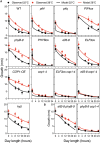COP1 dynamics integrate conflicting seasonal light and thermal cues in the control of Arabidopsis elongation
- PMID: 35984876
- PMCID: PMC9390991
- DOI: 10.1126/sciadv.abp8412
COP1 dynamics integrate conflicting seasonal light and thermal cues in the control of Arabidopsis elongation
Abstract
As the summer approaches, plants experience enhanced light inputs and warm temperatures, two environmental cues with an opposite morphogenic impact. Key components of this response are PHYTOCHROME B (phyB), EARLY FLOWERING 3 (ELF3), and CONSTITUTIVE PHOTOMORPHOGENIC 1 (COP1). Here, we used single and double mutant/overexpression lines to fit a mathematical model incorporating known interactions of these regulators. The fitted model recapitulates thermal growth of all lines used and correctly predicts thermal behavior of others not used in the fit. While thermal COP1 function is accepted to be independent of diurnal timing, our model shows that it acts at temperature signaling only during daytime. Defective response of cop1-4 mutants is epistatic to phyB-9 and elf3-8, indicating that COP1 activity is essential to transduce phyB and ELF3 thermosensory function. Our thermal model provides a unique toolbox to identify best allelic combinations enhancing climate change resilience of crops adapted to different latitudes.
Figures






Similar articles
-
Red-light-dependent interaction of phyB with SPA1 promotes COP1-SPA1 dissociation and photomorphogenic development in Arabidopsis.Mol Plant. 2015 Mar;8(3):467-78. doi: 10.1016/j.molp.2014.11.025. Epub 2014 Dec 30. Mol Plant. 2015. PMID: 25744387
-
Regulation of COP1 Function by Brassinosteroid Signaling.Front Plant Sci. 2020 Jul 31;11:1151. doi: 10.3389/fpls.2020.01151. eCollection 2020. Front Plant Sci. 2020. PMID: 32849709 Free PMC article.
-
High-level expression and phosphorylation of phytochrome B modulates flowering time in Arabidopsis.Plant J. 2015 Sep;83(5):794-805. doi: 10.1111/tpj.12926. Epub 2015 Jul 18. Plant J. 2015. PMID: 26120968
-
PIFs- and COP1-HY5-mediated temperature signaling in higher plants.Stress Biol. 2022 Aug 30;2(1):35. doi: 10.1007/s44154-022-00059-w. Stress Biol. 2022. PMID: 37676326 Free PMC article. Review.
-
The role of COP1 in repression of photoperiodic flowering.F1000Res. 2016 Feb 16;5:F1000 Faculty Rev-178. doi: 10.12688/f1000research.7346.1. eCollection 2016. F1000Res. 2016. PMID: 26949521 Free PMC article. Review.
Cited by
-
The heat response regulators HSFA1s promote Arabidopsis thermomorphogenesis via stabilizing PIF4 during the day.Sci Adv. 2023 Nov 3;9(44):eadh1738. doi: 10.1126/sciadv.adh1738. Epub 2023 Nov 3. Sci Adv. 2023. PMID: 37922351 Free PMC article.
-
UV-B increases active phytochrome B to suppress thermomorphogenesis and enhance UV-B stress tolerance at high temperatures.Plant Commun. 2025 Jan 13;6(1):101142. doi: 10.1016/j.xplc.2024.101142. Epub 2024 Oct 10. Plant Commun. 2025. PMID: 39390743 Free PMC article.
-
Light signaling-mediated growth plasticity in Arabidopsis grown under high-temperature conditions.Stress Biol. 2022 Dec 15;2(1):53. doi: 10.1007/s44154-022-00075-w. Stress Biol. 2022. PMID: 37676614 Free PMC article. Review.
-
Mathematical Modeling of Photo- and Thermomorphogenesis in Plants.Methods Mol Biol. 2024;2795:247-261. doi: 10.1007/978-1-0716-3814-9_23. Methods Mol Biol. 2024. PMID: 38594544
-
A multisensor high-temperature signaling framework for triggering daytime thermomorphogenesis in Arabidopsis.Nat Commun. 2025 Jun 4;16(1):5197. doi: 10.1038/s41467-025-60498-7. Nat Commun. 2025. PMID: 40467614 Free PMC article.
References
-
- Casal J. J., Photoreceptor signaling networks in plant responses to shade. Annu. Rev. Plant Biol. 64, 403–427 (2013). - PubMed
-
- Gommers C. M. M., Visser E. J. W., Onge K. R. S., Voesenek L. A. C. J., Pierik R., Shade tolerance: When growing tall is not an option. Trends Plant Sci. 18, 65–71 (2013). - PubMed
-
- Jung J.-H., Domijan M., Klose C., Biswas S., Ezer D., Gao M., Khattak A. K., Box M. S., Charoensawan V., Cortijo S., Kumar M., Grant A., Locke J. C. W., Schäfer E., Jaeger K. E., Wigge P. A., Phytochromes function as thermosensors in Arabidopsis. Science 354, 886–889 (2016). - PubMed
-
- Legris M., Klose C., Burgie E. S., Rojas C. C. R., Neme M., Hiltbrunner A., Wigge P. A., Schäfer E., Vierstra R. D., Casal J. J., Phytochrome B integrates light and temperature signals in Arabidopsis. Science 354, 897–900 (2016). - PubMed
LinkOut - more resources
Full Text Sources
Molecular Biology Databases
Research Materials

